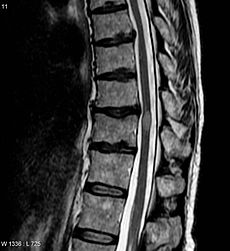Transverse Myelitis
Original Editor - Wendy Walker
Lead Editors Wendy Walker
Introduction
[edit | edit source]
Transverse Myelitis (TM), AKA Acute Transverse Myelitis (ATM) is a rare neurological disorder of the spinal cord, caused by inflammation and occurring across one spinal segment, leading to severe motor, sensory and autonomic dysfunction[1].
The term Transverse Myelitis (TM) was first coined in 1948 by Dr Suchett-Kaye, an English neurologist. He uses this to describe a case of rapidly progressive paraparesis with a thoracic sensory level, occurring as a post-infectious complication of pneumonia.
In the MRI scan opposite, the TM lesion is the lighter, oval shape at center-right.
Epidemiology[edit | edit source]
The incidence of TM is 1 (severe) to 8 (mild) cases/million per year[2].
It occurs in adults and children, in both genders, and in all races.
A peak in incidence rates (the number of new cases per year) appears to occur between 10 and 19 years and 30 and 39 years.
Mechanism of Injury / Pathological Process
[edit | edit source]
The mechanism of injury is inflammation of the spinal cord causing damage to the myelin sheath of the nerves.
Clinical Presentation[edit | edit source]
- Sensory, motor, or autonomic dysfunction attributable to the spinal cord
- Bilateral signs and/or symptoms
- Clearly defined sensory level
The symptoms of TM include muscle weakness, paralysis, parasthesia, neuropathic pain, spasticity, as well as bladder, bowel and sexual dysfunction.
In some cases, symptoms progress over hours whereas in other instances, the presentation is over days. Neurologic function tends to decline during the 4-21 day acute phase, while eighty-percent of cases reach their maximal deficit within 10 days of symptom onset. At its worst point, 50% of individuals have lost all movements of their legs, 80-94% experience numbness, paresthesias or banding or girdling, and almost all have some degree of bladder dysfunction.
There is tremendous variability in the presentation of symptoms, which are based on the level of the spinal cord affected and on the severity of the damage to the myelin and the neurons in the spinal cord.
Some patients recover from transverse myelitis with minor or no residual problems.
Others suffer permanent impairments that affect their ability to perform ordinary tasks of daily living.
Most people will have only one episode of transversemyelitis.
A small percentage (10-20%) may have a recurrence.
Diagnostic Procedures[edit | edit source]
add text here relating to diagnostic tests for the condition
Outcome Measures[edit | edit source]
add links to outcome measures here (see Outcome Measures Database)
Management / Interventions
[edit | edit source]
add text here relating to management approaches to the condition
Differential Diagnosis
[edit | edit source]
The most common etiologies to be distinguished from idiopathic acute transverse myelitis are:
Parainfectious myelitis
NMO (Devic's disease)
Myelitis related to systemic disease, such as systemic lupus erythematosis
Compression of spinal cord caused by trauma eg. vertebral fractures
Epidural or subdural hematoma
Epidural and/or paraspinal abscess
Tumour
Key Evidence[edit | edit source]
add text here relating to key evidence with regards to any of the above headings
Resources
[edit | edit source]
add appropriate resources here
Case Studies[edit | edit source]
add links to case studies here (case studies should be added on new pages using the case study template)
Recent Related Research (from Pubmed)[edit | edit source]
Extension:RSS -- Error: Not a valid URL: Feed goes here!!|charset=UTF-8|short|max=10
References[edit | edit source]
References will automatically be added here, see adding references tutorial.







